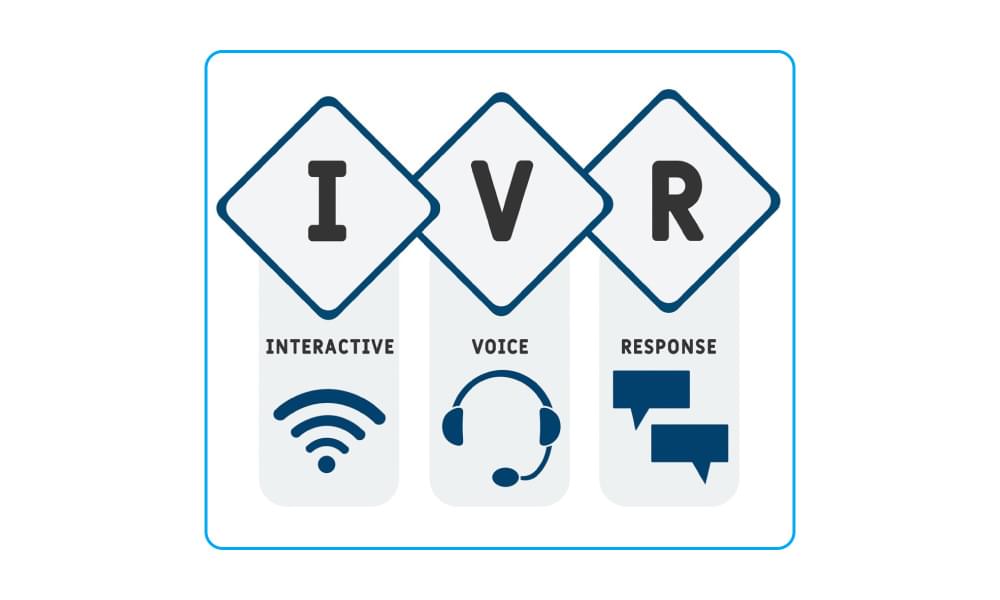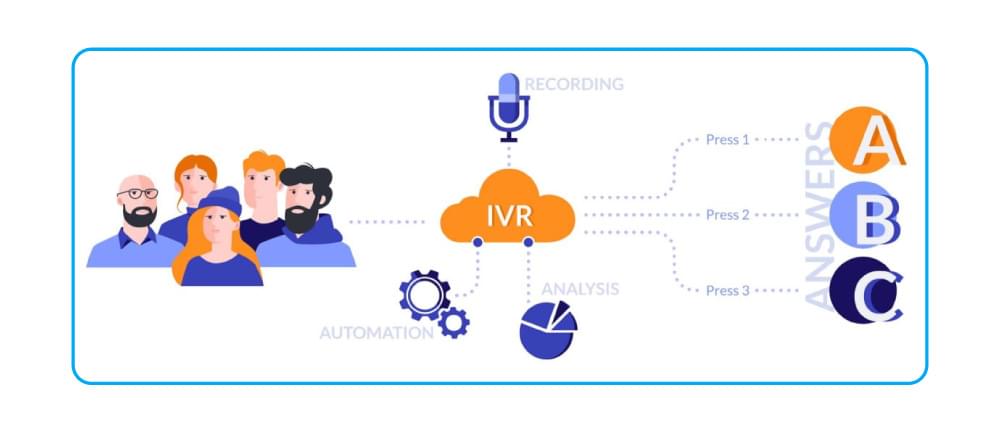voice technology tutorials
What is Interactive Voice Response (IVR)? Meaning & Use Case
Quick and efficient customer service is the key to winning over your target audience and making them your loyal customers. Interactive Voice Response (IVR) is one such technology that has transformed the way organizations engage with their audience.
But, not many people know what exactly IVR is and how it can benefit your organization. In this article, we will explore the meaning of IVR, its working process, benefits, challenges, and real-world use cases.
Table of Contents
- What is IVR?
- How Does Interactive Voice Response Systems Work?
- Benefits of Using IVR
- Key Challenges of IVR
- Real-World Use Cases of IVR
- Popular IVR Solutions
- Conclusion
- FAQs
What is IVR?
IVR stands for Interactive Voice Response. It is an automated telephone system technology that interacts with callers to gather relevant information and route the calls to suitable recipients.
In other words, the IVR system is the technology used in computers to interact with humans via voice without speaking to a live agent. It is possible because IVR has pre-recorded messages in the background or text-to-speech technology with a dual-tone multi-frequency (DTMF) interface.

The simplest way to understand what is an IVR system is that when you call a company and hear an automated greeting saying, “Press 1 for support” etc, you are actually interacting with IVR technology. Hence, IVR systems act as virtual receptionists that can handle a large volume of calls efficiently with no human intervention.
Key Components of IVR Systems
Now that we know that Interactive Voice Response (IVR) offers two-way communication between automated systems and human callers let’s dive into the technical definition of IVR by understanding its key components:
- Voice Recognition Software: Allows the system to understand spoken words and commands.
- Text-to-Speech (TTS) Engine:: Converts text into spoken words to interact with the caller.
- DTMF Processing: Interprets the tones generated when callers press keypad buttons to select different options.
- Database Integration: Provides access to customer records and relevant information to offer better support.
- Call Routing Logic: Directs calls to the relevant team based on predefined rules and caller inputs.
How Does Interactive Voice Response Systems Work?
Understanding the workings of IVR systems requires looking at its key operations step by step. An IVR system typically follows these steps:
- Call Reception: The system answers incoming calls with a pre-recorded greeting.
- Information Collection: The IVR prompts callers to provide information via voice commands or keypad entries.
- Data Processing: The system processes the caller’s input against its programmed logic and database information.
- Response Generation: The IVR system generates a suitable response on the basis of data processing.
- Call Resolution / Routing: The call is either resolved by the automated system or transferred to the relevant agent.
Modern IVR systems are much more than just menu-based interfaces. Advancements in AI and natural language processing allow the latest IVR systems to understand and analyze complex queries and also offer more complex responses.
Related: Everything to Answer What is TTS (Text to Speech) Software
Benefits of Using IVR
Following are some of the many benefits of using interactive voice response systems for businesses in different industries:
1. Cost-Efficiency
Reducing the cost of customer support is an important benefit of IVR technology. Businesses can automate routine inquiries and call routing to minimize the need for having a large customer support team. In fact, studies indicate that a well-designed IVR system can handle up to 80% of regular customer queries without human intervention. It ultimately translates into significant operational savings.
2. Availability
Human agents have limited working hours. As a result, companies dependent on human agents can only offer limited customer services. IVR systems, on the other hand, can work 24/7 and offer round-the-clock customer service.
3. Improve Call Handling Efficiency
| Metric | Without IVR | With IVR | Improvement |
|---|---|---|---|
| Average Wait Time | 3-5 minutes | <1 minute | 70-80% reduction |
| Call Abandonment Rate | 15-20% | 5-8% | 60-70% reduction |
| First Call Resolution | 65% | 85% | 30% increase |
| Agent Productivity | Base | +35% | 35% increase |
4. Improve Customer Experience
Modern IVR systems are capable of personalizing interactions with customers based on caller history. Hence, businesses can offer more targeted and efficient services by predicting their requirements. It results in better customer experience and satisfaction.
5. Collect Data
Data collection is important for businesses that want to make data-driven decisions. IVR systems can collect important data from their interaction with the customers and thoroughly analyze the data to find opportunities for improvement. Overall, such information is useful for businesses to optimize their operations and provide better customer service.
6. Scalability
Human agents have a certain limit to the number of calls they can handle on a daily basis. On the other hand, IVR systems are quite scalable in nature, so they handle a large volume of calls quickly and easily.
Such kind of scalability becomes even more important during peak periods to ensure you can handle a large number of clients without needing additional staff and without compromising on the quality of customer service.
Key Challenges of IVR
It is evident that IVR has many benefits. However, it does not mean that implementing IVR systems does not have its own share of significant challenges:
1. User Frustration
Poorly designed IVR systems can end up frustrating the users. Some of the common complaints include complex menu structures, lack of access to a human agent, and failure of the IVR system to recognize voice commands.
2. Complex Design
Careful planning and user-friendly design are essential to create an effective IVR system. There needs to be a perfect balance between efficiency and usability in an IVR system. It ensures that callers can quickly access the required information or even get to a human agent without getting lost in menu options.
3. Integration Issues
Integrating IVR systems with existing customer relationship management (CRM) platforms can be a huge challenge for many businesses. Therefore, it is important to consider the integration capabilities to provide personalized service and access relevant customer information.

4. Regular Updates
IVR systems need continuous maintenance and updates to provide reliable and effective services. Moreover, business processes often tend to evolve with time, and such changes should be reflected in IVR as well.
5. Balance Between Automation & Human Touch
Finding the right balance between automation and human interaction is important. IVR systems are definitely capable of handling routine inquiries, but you need human intervention to handle complex issues. Therefore, the IVR must have a clear pathway to human agents.
Real-World Use Cases of IVR
The interactive voice response technology has applications in diverse industries and specific scenarios. Here are some prominent use cases of the IVR technology:
1. Financial Industry
IVR systems handle a wide range of functions in the financial sector, such as:
- Account Balance Inquiries: Customers can check their account balances without speaking to a human representative.
- Transfer Funds: IVR can transfer funds between accounts.
- Obtain Transaction History: Users can review recent transactions through automated systems.
- Card Activation/Deactivation: New cards can be activated or lost cards can be deactivated via IVR.
- Process Loan Payments: Customers can make loan payments and check their statuses.
2. Healthcare
Healthcare providers also use IVR technology to handle various common processes:
- Schedule Appointment: Patients can book or reschedule appointments and receive reminders.
- Lab Result Notifications: Basic lab results can be notified via IVR systems.
- Insurance Verification: Patients can verify insurance coverage before appointments.
- Hospital Surveys: Post-care surveys collect patient feedback for service improvement.
3. Telecommunications
A large majority of telecom companies use IVR for:
- Bill Payment: Customers can pay bills and check payment status.
- Service Activation/Deactivation: Users can activate/deactivate services.
- Technical Support: IVR systems can troubleshoot common issues.
- Plan Modification: Subscribers can modify service plans.
4. Retail Industry
The retail and e-commerce industry can also benefit from IVR systems by handling:
- Order Status Tracking: Customers can track their orders via IVR.
- Return Processing: Automated systems facilitate product return procedures.
- Promotional Information: Systems can deliver information about current sales and promotions.
5. Government Services
Government agencies and institutes can also use IVR for:
- Tax Information: Citizens can access tax filing information and payment options.
- Benefit Status Checks: Recipients can verify the status of benefits without long wait times.
- License Renewals: Many agencies allow license renewals through automated systems.
- Voting Information: IVR systems provide polling locations and voting procedures.
- Public Service Announcements: Emergency information can be spread efficiently and quickly.
Related: Convert Text to Natural-Sounding Speech
Popular IVR Solutions
There are different types of IVR solutions available to fulfill different use cases and cater to varying industries. Here are some of the leading options:
- Cloud-Based IVR System: They offer flexibility, scalability, and help to reduce the overall IT infrastructure costs. Businesses with fluctuating call volumes should opt for these systems.
- On-Premise IVR System: Organizations with strict security requirements can choose on-premise IVR technology and have greater control over the hardware and software.
- AI-Powered Conversational IVR: The modern IVR systems are powered by AI to create a more natural and conversational environment.
- Use-Case Based Systems: Some of the text-to-speech systems can also be use case-based. For example, WebsiteVoice is a platform that uses the TTS technology to turn website articles and blogs into high-quality audio.
Conclusion
The bottom line is that the interactive voice response (IVR) has truly changed the way customer service works. Knowing what is IVR and the benefits of its implementation is important for every type and size of business to enhance their customer service and provide a more satisfying customer experience.
It is also important to note that IVR systems will continue to evolve with time just like how they have moved from simple menu-based to AI-powered solutions.
Ultimately, any advancement in voice recognition and AI technology will help the IVR systems become better at handling customer queries and provide excellent customer service with minimum human intervention.
FAQs
What does IVR stand for?
IVR stands for Interactive Voice Response. It is an automated phone system to interact with callers via voice commands or keypad inputs.
Is there any difference between IVR and auto-attendant?
Yes! An auto-attendant primarily focuses on routing calls based on the menu selected by the caller. IVR systems are more advanced in nature as they support database interactions and can also resolve simple customer queries.
Is IVR technology beneficial for small businesses?
Yes! IVR solutions are beneficial for all types and sizes of businesses because they are scalable and affordable.
How to set up an IVR?
Setting up an IVR typically has 4 main steps: plan the customer pathways, record your greetings, create the menu, and test the system.










